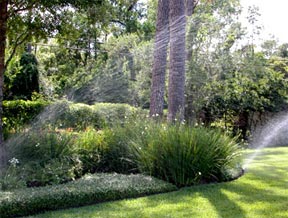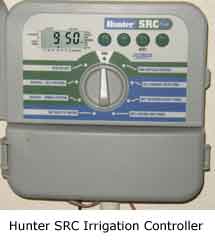An underground lawn sprinkler system can be installed in an average home yard, landscape and garden. In fact, some housing developments provide an underground sprinkler as standard equipment with the house complete with a irrigation timer making lawn watering easy. The advancements in the plastics field have brought about many new types of composition pipe which are the basis for these home systems.
Easy Installation, Less Expensive
Although an underground sprinkler system is now less expensive and more easily installed, it is something which still must be analyzed and carefully planned if it is to work satisfactorily. The actual labor of installation is simple… any good handyman can do it. The more tricky job is actually laying out the system on paper so that the area to be watered will be thoroughly covered with the water that is available from the house. But it can be done!

The installation of an underground sprinkler is still more expensive than the standard, hose-attached sprinkler. But the convenience of watering your lawn merely by turning a valve or switch is worth the extra cost to many people. Another reason to carefully plan your system is that an underground system is permanent. To save many heartaches and extra work, it should be installed properly at the start. This cannot be stressed too much.
How Many Sprinkler Heads?
Your first consideration is determining how much lawn you want covered and the number of individual sprinkler heads needed. This is not too difficult to figure out. The various manufacturers (Hunter, K-Rain, Nelson, Rain Bird, Roberts, Toro, Weather-Matic) offer a set of instructions just some graph paper so you can spot sprinkler heads on a scale drawing. The radius covered by each head will vary from 7 to 10 feet, depending on the make. It is also possible to have heads which will spray a half- or even quarter circle so that water will not be wasted on the sidewalks or on the driveways.
You may need some assistance from an irrigation professional for the next steps in planning your system. Now you have to determine the amount of water the system will use. Each head sprays a certain amount of water… from 1 to 2 gallons a minute, depending on the make and the total volume of water needed for the system is figured by multiplying the number of heads by the amount each uses.
Estimate Water Volume
The volume of water available from the house must be estimated. This can be computed from your water meter; if you have no meter, the number of heads you can effectively operate can be determined from the water pressure. Installing a irrigation pump is a more common option.
From these figures you will know if your system will, operate properly or not. For instance, if your system will use 30 gallons of water a minute and you have 45 gallons available, it will work fine. On the other hand, if your system calls for 60 gallons of water a minute and you only have 30 gallons available, it will mean that the system will have to be laid out so that only half will be operating at one time. This is done by a series of valves or zones.
Watering Zones
A lawn area can be laid out in separate sections or zones as many as will be needed so that it is possible to have an underground sprinkler no matter what your water volume or the size of the lawn. One manufacturer has adjustable heads so the volume of water can be regulated without materially changing the spray area.
With all these variables, then, it is wise to consult with an irrigation dealer or irrigation specialist who is thoroughly informed about the options and the particular system you want to advise you in planning.
Complete Sprinkler Installation or DIY
Underground sprinklers are sold in two ways. You can buy all the individual components so that each system can be started from scratch. The other way is to buy a kit (this usually covers a specific area). In addition, though, components are also available to augment the kits if the need calls for them. There should be little problem of water consumption with the kits since they usually have but six or seven sprinkler heads which the average home water supply will easily handle. However, if you are considering hooking up two or more kits to operate at the same time, you had better investigate your available water volume first.

Anti-siphon devices are mandatory on underground sprinkler systems in some localities. These are mechanisms which prevent water from backing up through the sprinkler system and into the house water supply or the water table should the main-line pressure fail. Although it is not absolutely necessary to install them in every locality, it is still a good idea. They are hooked up between the main house supply or pump and the sprinkler system.
To install an underground sprinkler system, it is not necessary to dig up large portions of the lawn. The plastic pipe PVC is laid in slits cut with a spade or machine. No sod should have to be removed. Once the pipe is in position so the sprinkler heads are even with the lawn surface… the sod is brought together again.
PVC pipes are used for most underground sprinklers today. Fittings and spray heads are either metal or plastic. On some systems, the plastic pipe is actually threaded; others use a special adhesive to join sections together.
Portable Sprinkler Systems Still Popular
Underground sprinklers are not the only type available by any means. Many people still prefer the type which is connected to the hose. Naturally they don’t offer the convenience of an under- ground system, but they are more versatile in that they can be used for both lawn and garden.
Oscillating sprinklers are quite popular with many gardeners. This type which has a single arm with many jets that rock back and forth sprays in a rectangular pattern. Many lawns are rectangular in shape and suited for this type sprinkler. Also, it is quite easy to situate the sprinkler to prevent overlapping of spray pattern.
Rotating sprinklers are another type with moving parts. This has an arm which is whirled around. Naturally, it sprays in a circular pattern. Some of these are on a spike which can be inserted in the ground with the spraying head several feet high to give a larger spray pattern.
Stationary sprinklers are like the underground heads in that they have no moving parts. These, too, spray in a circular pattern.
Irregular areas are easily conquered with a flexible hose-type sprinkler. These resemble a section of hose but have perforations on one side. They come in lengths of 25 and 50 feet and cover quite an area of lawn.
Soakers are similar to flexible sprinklers only these direct the water down rather than in the air. Some are made of porous material, and the water oozes out.
Nozzles, root waterers and watering wands just about complete the array of watering equipment. Nozzles, of course, give a spray pattern which can be adjusted. Root waterers are plunged into the soil to water at the root level. Watering wands are like elongated nozzles but the water does not come out under pressure. These are used for watering close to the base of a plant when you do not want to wet the foliage.
